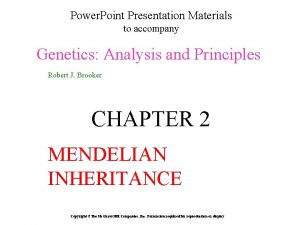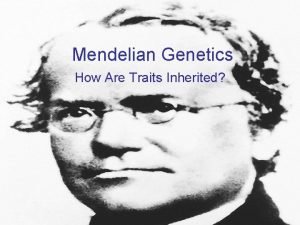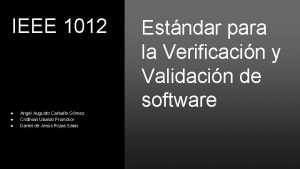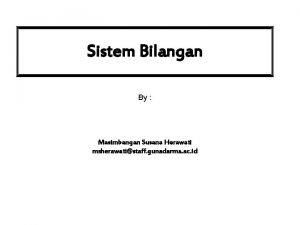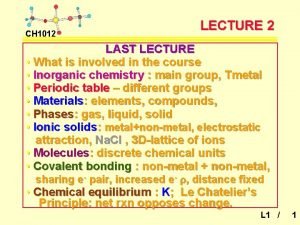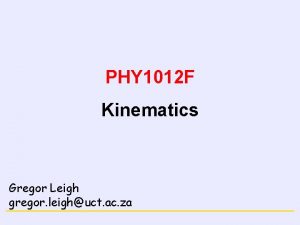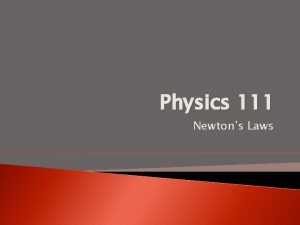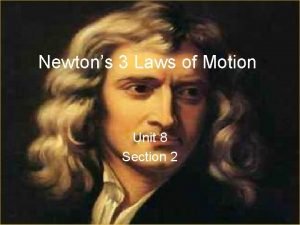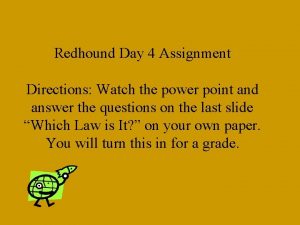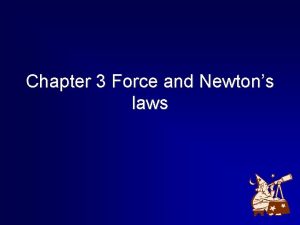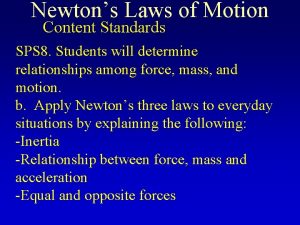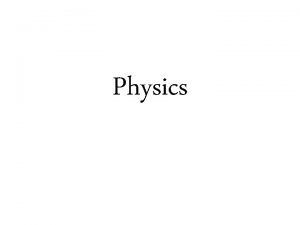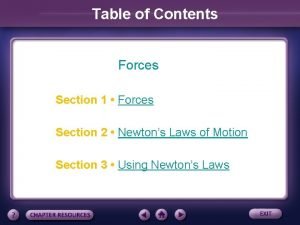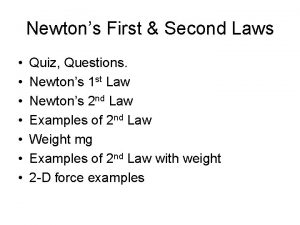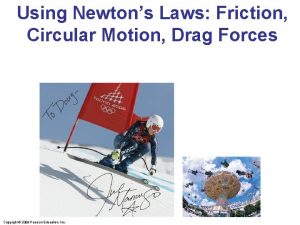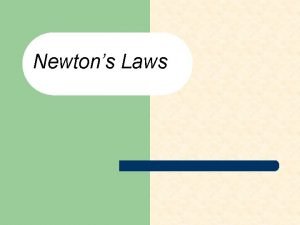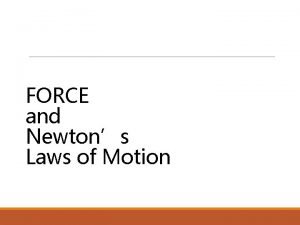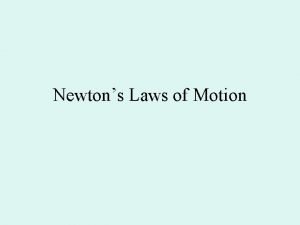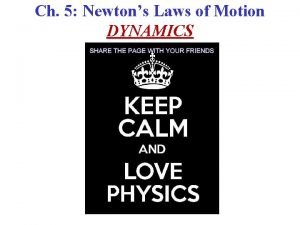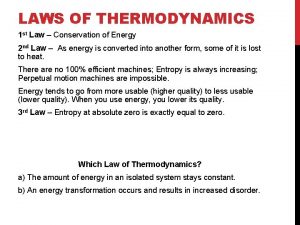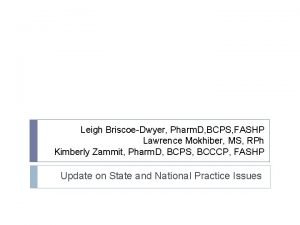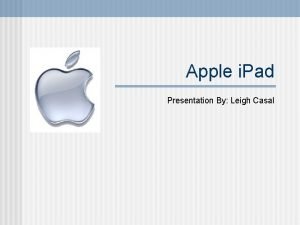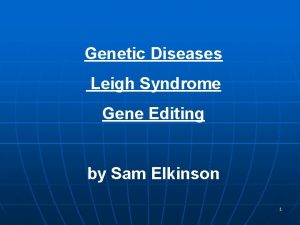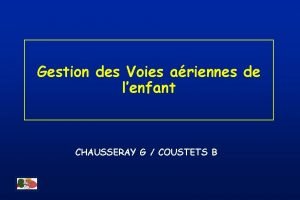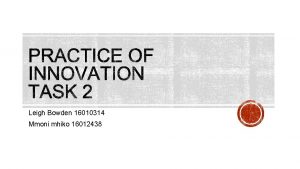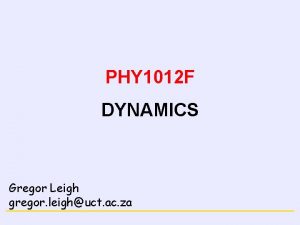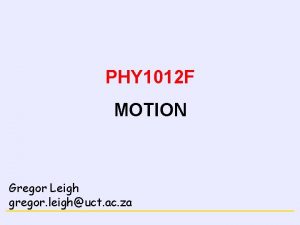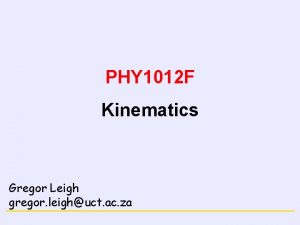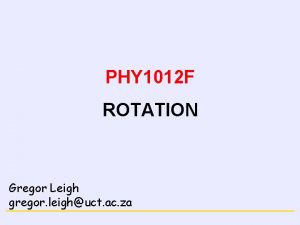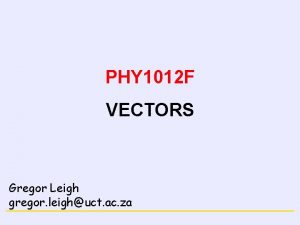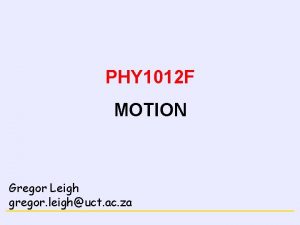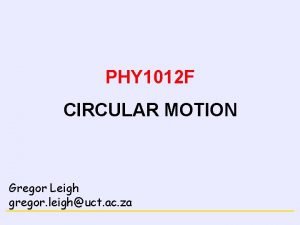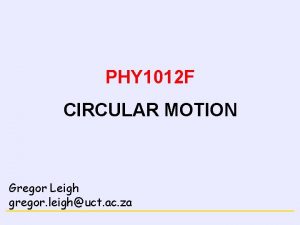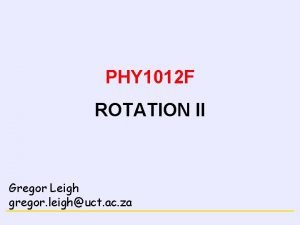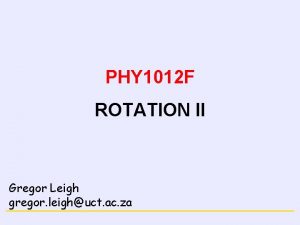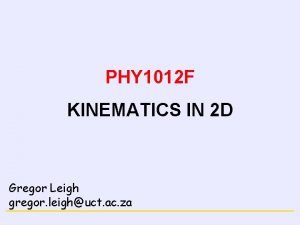NEWTONS LAWS PHY 1012 F DYNAMICS Gregor Leigh

















































- Slides: 49

NEWTON’S LAWS PHY 1012 F DYNAMICS Gregor Leigh gregor. leigh@uct. ac. za FORCE and MOTION

PHY 1012 F NEWTON’S LAWS FORCE and MOTION Learning outcomes: At the end of this chapter you should be able to… Correctly identify specific forces acting on “the system of interest”. Draw free-body diagrams as part of a problem-solving strategy for dealing with dynamics problems. Apply Newton’s laws of motion usefully and consistently to dynamics problems – developing a “Newtonian intuition” of the connection between force and change in motion (acceleration). 2

PHY 1012 F NEWTON’S LAWS FORCE and MOTION FORCE The force of one object on a second object is part of the mutual interaction between the two objects. The other part of this interaction is the equal and opposite force which the second object exerts on the first. It is more convenient to consider the forces acting on one object at a time. The other object is the necessary agent. The force of the agent has “some effect”, i. e. a push or a pull, on the other object. Force is a vector quantity. Whether the force is a push or a pull, graphically we always place the tail of its ray on the affected object. 3

PHY 1012 F NEWTON’S LAWS FORCE and MOTION THE FUNDAMENTAL FORCES OF NATURE Our current understanding is that there are only four fundamental forces in nature: the gravitational force (between objects which have mass); the electromagnetic force (between objects which are charged); the strong nuclear force (between protons and neutrons); the weak nuclear force (which results in radioactive beta decay). (In mechanics problems the last two forces are not significant, but the electromagnetic force is in fact responsible for macroscopic “contact” forces (qv). ) 4

PHY 1012 F NEWTON’S LAWS FORCE and MOTION SUPERPOSITION OF FORCES If several forces act simultaneously on a body, we can determine what is variously called the net force, resultant force, or total force, the sum of all the forces, by applying the principle of superposition of forces and using vector addition: 5

PHY 1012 F NEWTON’S LAWS FORCE and MOTION Aristotle : Objects behave according to their “nature”. By nature, all objects tend to be at rest in their “proper” positions. “Natural motion” is simply objects striving to return to where they naturally belong. Things of the earth (e. g. stones) fall; things of the air (e. g. smoke) rise. Heavier objects, being more of the earth, fall faster than light objects. Motion imposed by an pushing or pulling agent is “violent motion” and persists only while the action is sustained. 6

PHY 1012 F NEWTON’S LAWS FORCE and MOTION How about that! Galileo: In the absence of air resistance, all objects fall at the same rate. a 7

PHY 1012 F NEWTON’S LAWS FORCE and MOTION Galileo: In the absence of air resistance, all objects fall at the same rate. a 8

PHY 1012 F NEWTON’S LAWS FORCE and MOTION Galileo: In the absence of air resistance, all objects fall at the same rate. a In the absence of friction or other opposing forces, a horizontally moving object will continue moving indefinitely. The property of an object which causes it to tend to “continue doing what it is doing” is called inertia. 9

PHY 1012 F NEWTON’S LAWS FORCE and MOTION Newton: 1. Any system in mechanical equilibrium remains in mechanical equilibrium unless compelled to change that state by a non-zero net force acting on the system. 2. The acceleration of a system is directly related to the net force acting on the system: 3. Forces are interactions between systems. 10

PHY 1012 F NEWTON’S LAWS FORCE and MOTION SYSTEMS and ENVIRONMENTS A “system” refers to the object (or collection of objects) on which the forces under consideration are acting. Everything else is the environment. We shall deal only with systems of constant mass. In the particle model… the system is treated as a single point of mass; a system cannot exert forces on itself. 11

PHY 1012 F NEWTON’S LAWS FORCE and MOTION NEWTON’S FIRST LAW “An object which is at rest will remain at rest, or an object which is moving will continue to move with constant velocity, if and only if the net force acting on the object is zero. ” Key phrases: at rest: the system is in static equilibrium constant velocity: the system is in dynamic equilibrium constant velocity: neither speed nor direction changes if and only if: no change no force; no force no change net force: balanced forces may be present, but effect no change 12

PHY 1012 F NEWTON’S LAWS FORCE and MOTION NEWTON’S FIRST LAW static equilibrium dynamic equilibrium mechanical equilibrium A system in (mechanical) equilibrium has zero accel-eration and defines what we mean by zero total force. Newton’s first law is also known as the law of inertia [Latin, inertia : slothfulness, sluggishness, laziness]. Inertia is the property of a body which causes it to resist acceleration. 13

PHY 1012 F NEWTON’S LAWS FORCE and MOTION FORCES CATALOG gravitational electromagnetic strong nuclear weak nuclear long-range forces act at a distance short-range forces contact forces apply only while the specific agent is in contact with the system! 14

PHY 1012 F NEWTON’S LAWS FORCE and MOTION FORCES CATALOG Weight, … is the gravitational pull of the entire Earth on any system with mass (!), near the surface of the Earth; is a vector quantity which points downwards (towards the centre of the Earth); is a long-range force, and works equally on stationary or moving systems; is sometimes used to refer to only the magnitude of the weight force, w, given by w = mg; is sometimes used INCORRECTLY when referring to the mass of an object. (As is the verb “weigh”. ) 15

PHY 1012 F NEWTON’S LAWS FORCE and MOTION FORCES CATALOG Spring force, … is applied by elastic objects, which have been temporarily deformed, as they attempt to regain their original shapes; s s (Hooke’s Law) where k, the spring constant, depends on the spring material. s 16

PHY 1012 F NEWTON’S LAWS FORCE and MOTION FORCES CATALOG Tension force, … (T 1 = T 2) is applied by flexible materials, such as string, rope, wire, etc. (which are ideally modelled as massless and non-stretchable); is applied in the direction of the string or rope (it is difficult to use a length of string to push something!); has a scalar counterpart referred to simply as tension, which is equal in magnitude to the force applied by each end of the string – and therefore also equal to the force applied to each end of the string. 17

PHY 1012 F NEWTON’S LAWS FORCE and MOTION FORCES CATALOG Normal force, … is applied by any surface touching the system; is applied at right angles (i. e. normal ) to the surface; is the force which prevents a system falling as a consequence of its weight. (Bodies in free-fall are NOT weightless – they are simply normal-force-less!) balances, on horizontal surfaces, the system’s weight… More generally, however, 18

PHY 1012 F NEWTON’S LAWS FORCE and MOTION FORCES CATALOG Friction, … appears (it is a responsive force) when a system moves or tries to move, across a surface; acts parallel to the contact surface; is called static friction, , when it prevents motion (i. e. the system is stuck to the surface); is called kinetic friction, , when it opposes motion (i. e. the system is sliding over the surface); The magnitude of … is proportional to the normal force on the system; depends on the nature of both contact materials. 19

PHY 1012 F NEWTON’S LAWS FORCE and MOTION FORCES CATALOG Static friction, … acts in equilibrium with an applied force parallel to the surface, adjusting its magnitude to balance the force – but only up to a maximum, . After this the system slips and starts to move; (direction opposite attempted motion) where s, the coefficient of static friction, is a dimensionless number which must be determined by experiment. 20

PHY 1012 F NEWTON’S LAWS FORCE and MOTION FORCES CATALOG Kinetic friction, … replaces static friction once the system has begun to slide; has a magnitude (less than ) which is nearly constant, irrespective of the system’s speed relative to the surface; (direction opposite motion) where k, the coefficient of kinetic friction, is a dimensionless number which must be determined by experiment. 21

PHY 1012 F NEWTON’S LAWS FORCE and MOTION FORCES CATALOG Rolling friction, … results from “welds” formed between the molecules in a wheel and those of the surface over which it rolls – bonds which must be broken as the wheel rolls and its molecules lift off the surface; (direction opposite forward motion) where r, the coefficient of rolling friction, is very much lower than k or s. 22

PHY 1012 F NEWTON’S LAWS FORCE and MOTION FORCES CATALOG Approximate values for some coefficients of friction: static, s kinetic, k rolling, r rubber / tarmac (dry) 1. 00 0. 80 0. 02 steel / steel (dry) 0. 80 0. 60 0. 002 steel / steel (lubricated) 0. 10 0. 05 teflon / teflon or steel 0. 04 synovial joints (human) 0. 01 rubber / tarmac (wet) 0. 80 0. 50 materials 23

PHY 1012 F NEWTON’S LAWS FORCE and MOTION FORCES CATALOG Drag, … is the resistive force experienced by a system moving relative to a fluid (gas or liquid); increases with increasing relative speed; for objects of moderate cross-sectional area, A, and moderate speed, v, moving through air at the surface of the Earth is approximated by Note: Air resistance may be neglected in all problems unless a problem explicitly states that it must be taken into account. 24

PHY 1012 F NEWTON’S LAWS FORCE and MOTION FORCES CATALOG Thrust, … is the reactive force which a surface (or a system’s own exhaust) exerts on the system as a result of the system exerting a force on the surface (or exhaust). Note: Even though the exhaust may be a gas, it nevertheless constitutes a tangible agent in contact with the system. 25

PHY 1012 F NEWTON’S LAWS FORCE and MOTION FREE-BODY DIAGRAMS A free-body diagram represents a system as a particle and uses rays to show all the forces acting on the system. 1. 2. 3. Draw a picture of the situation. 4. Redraw the system as a particle with the lengths of the force vectors representing their magnitudes (if possible). 5. 6. Draw convenient coordinate axes centred on the particle. Resolve forces into components where necessary. Circle the system of interest on your picture. Identify all the significant forces acting on the system and draw and label them. (Wherever the environment touches the system you will find contact forces. Include relevant long-range forces, such as gravity. ) 26

PHY 1012 F NEWTON’S LAWS FORCE and MOTION FREE-BODY DIAGRAMS A 5 kg box is being pulled up a 37° slope by a rope parallel to the slope. If k = 0. 40 and the tension in the rope is 60 N, what is the acceleration of the block? 5 kg 37° 1. Draw a picture of the situation. 27

PHY 1012 F NEWTON’S LAWS FORCE and MOTION FREE-BODY DIAGRAMS A 5 kg box is being pulled up a 37° slope by a rope parallel to the slope. If k = 0. 40 and the tension in the rope is 60 N, what is the acceleration of the block? 5 kg 37° 2. Circle the system of interest on your picture. 28

PHY 1012 F NEWTON’S LAWS FORCE and MOTION FREE-BODY DIAGRAMS A 5 kg box is being pulled up a 37° slope by a rope parallel to the slope. If k = 0. 40 and the tension in the rope is 60 N, what is the acceleration of the block? ? ! 5 kg 37° 3. Identify all the significant forces acting on the system and draw and label them. 29

PHY 1012 F NEWTON’S LAWS FORCE and MOTION FREE-BODY DIAGRAMS A 5 kg box is being pulled up a 37° slope by a rope parallel to the slope. If k = 0. 40 and the tension in the rope is 60 N, what is the acceleration of the block? 4. Redraw the system as a particle with the lengths of the force vectors representing their magnitudes. 30

PHY 1012 F NEWTON’S LAWS FORCE and MOTION FREE-BODY DIAGRAMS A 5 kg box is being pulled up a 37° slope by a rope parallel to the slope. If k = 0. 40 and the tension in the rope is 60 N, what is the acceleration of the block? y x 5. Draw convenient coordinate axes centred on the particle (one axis usually points in dir’n of motion). 31

PHY 1012 F NEWTON’S LAWS FORCE and MOTION FREE-BODY DIAGRAMS A 5 kg box is being pulled up a 37° slope by a rope parallel to the slope. If k = 0. 40 and the tension in the rope is 60 N, what is the acceleration of the block? y x 37° 6. Resolve forces into components along the axes where necessary. 32

PHY 1012 F NEWTON’S LAWS FORCE and MOTION NEWTON’S SECOND LAW “A system of mass m subjected to a number of forces whose vector sum is undergoes an acceleration (in the direction of ) which is directly proportional to and inversely proportional to the mass of the system. ” Notes: . is the vector sum of all the individual forces acting on the system. If , the system is in equilibrium. This does not mean that there are NO forces acting on the system, merely that the vector sum of all the forces is zero (i. e. the forces are all “balanced” – a term which may be used ONLY when referring to forces acting on a single system). 33

PHY 1012 F NEWTON’S LAWS FORCE and MOTION NEWTON’S SECOND LAW More notes: m is the inertial mass of the system, which relates the response of the system to the total force on it. (Mass can thus be regarded as a numerical measure of inertia. ) The left and right sides of this equation are not equivalent. On the left are the physical forces acting on the system; the right represents the system’s response to these forces. Units: [kg m/s 2 newton, N] One newton is the force required to accelerate a 1 kg mass at 1 m/s 2. 34

PHY 1012 F NEWTON’S LAWS FORCE and MOTION A 5 kg box is being pulled up a 37° slope by a rope parallel to the slope. If k = 0. 40 and the tension in the rope is 60 N, what is the acceleration of the block? y x = 0. 4 m = 5 kg Tx = 60 N ax = ? 35

PHY 1012 F NEWTON’S LAWS FORCE and MOTION WHAT EXACTLY DOES THAT SCALE MEASURE? 68 kg A resourceful engineering student investigates the motion of a lift simply by standing on an bathroom scale in the lift and taking certain readings. As the doors close on the ground floor, the scale reads 68 kg. The reading climbs to 77 kg for 3 s, returns to 68 kg for another 5 s, and then drops to 54 kg for a short while before settling once again on 68 kg as the doors open… …on which floor? ! (The building has 3. 63 m between floors. ) 54 kg 68 kg 77 kg 36

PHY 1012 F NEWTON’S LAWS FORCE and MOTION stop 68 kg 54 kg 68 kg start 77 kg 37

PHY 1012 F y 0 = v 0 y = t 0 = 0 a 0 y = ? y 1 = ? v 1 y = v 2 y = ? a 1 y = 0 y 2 = ? a 2 y = ? y 3 = ? v 3 y = 0 NEWTON’S LAWS FORCE and MOTION y t 1 = 3 s y 3, v 3 y, t 3 a 2 y t 2 = 3 + 5 = 8 s y 2, v 2 y, t 2 t 3 = ? a 1 y= 0 y 1, v 1 y, t 1 a 0 y y 0, v 0 y, t 0 0 38

PHY 1012 F NEWTON’S LAWS FORCE and MOTION y a 2 y a 1 y= 0 a 0 y 0 39

PHY 1012 F y 0 = v 0 y = t 0 = 0 a 0 y = 1. 30 m/s 2 y 1 = ? v 1 y = v 2 y = ? a 1 y = 0 y 2 = ? a 2 y = – 2. 02 m/s 2 y 3 = ? v 3 y = 0 NEWTON’S LAWS FORCE and MOTION y t 1 = 3 s y 3, v 3 y, t 3 a 2 y t 2 = 3 + 5 = 8 s y 2, v 2 y, t 2 t 3 = ? a 1 y= 0 y 1 = y 0 + v 0 y(t 1 – t 0) + ½a 0 y(t 1 – t 0)2 y 1 = 0 + ½ 1. 3 32 = 5. 84 m y 1, v 1 y, t 1 v 1 y = v 0 y + a 0 y(t 1 – t 0) v 1 y = 0 + 1. 3 3 = 3. 89 m/s a 0 y y 0, v 0 y, t 0 0 40

PHY 1012 F NEWTON’S LAWS y 0 = v 0 y = t 0 = 0 a 0 y = 1. 30 m/s 2 y 1 = 5. 84 m v 1 y = v 2 y = 3. 89 m/s t 1 = 3 s a 1 y = 0 y 2 = ? t 2 = 3 + 5 = 8 s a 2 y = – 2. 02 m/s 2 y 3 = ? v 3 y = 0 t 3 = ? FORCE and MOTION y y 3, v 3 y, t 3 a 2 y y 2, v 2 y, t 2 a 1 y= 0 y 2 = y 1 + v 1 y(t 2 – t 1) + ½a 1 y(t 2 – t 1)2 y 2 = 5. 84 + 3. 89 5 + 0 = 25. 3 m y 1, v 1 y, t 1 v 3 y = v 2 y + a 2 y(t 3 – t 2) 0 = 3. 89 + (– 2. 02)(t 3 – 8) a 0 y t 3 = 9. 93 s y 0, v 0 y, t 0 0 41

PHY 1012 F NEWTON’S LAWS y 0 = v 0 y = t 0 = 0 a 0 y = 1. 30 m/s 2 y 1 = 5. 84 m v 1 y = v 2 y = 3. 89 m/s t 1 = 3 s a 1 y = 0 y 2 = 25. 3 m t 2 = 3 + 5 = 8 s a 2 y = – 2. 02 m/s 2 y 3 = ? v 3 y = 0 t 3 = 9. 93 s FORCE and MOTION y y 3, v 3 y, t 3 a 2 y y 2, v 2 y, t 2 a 1 y= 0 y 3 = y 2 + v 2 y(t 3 – t 2) + ½a 2 y(t 3 – t 2)2 y 3 = 25. 3 + 3. 89 1. 93 + ½ (– 2. 02) 1. 932 y 1, v 1 y, t 1 y 3 = 29. 0 m She stops on the 8 th floor. a 0 y y 0, v 0 y, t 0 0 42

PHY 1012 F NEWTON’S LAWS FORCE and MOTION Determine the maximum starting acceleration of a F 1 car. y x In Formula 1 the thrust may be provided only by friction between the tyres and the track… 43

PHY 1012 F NEWTON’S LAWS FORCE and MOTION A cricket pitch roller has a mass of 350 kg. The coefficient of rolling friction between the roller and the pitch is 0. 06. If the handle of the roller makes an angle of 30° with the horizontal, explain (quantitatively) why it is easier for the groundsman to pull the roller at a constant speed rather than to push it. y y 30° x x 44

PHY 1012 F NEWTON’S LAWS y FORCE and MOTION y x x 45

PHY 1012 F NEWTON’S LAWS FORCE and MOTION NEWTON’S THIRD LAW “If system A exerts a force on another system B, then B exerts a force of the same magnitude on A but in the opposite direction. ” Notes: and are known as an action/reaction pair. Remember that and act on different systems and can therefore never be described as “balanced”. Systems connected by massless strings passing over massless, frictionless pulleys act as if they interact via an action/reaction pair. String merely “transmits” the force. 46

PHY 1012 F NEWTON’S LAWS FORCE and MOTION Two blocks are connected by a light, inextensible string which passes over a frictionless pulley as shown. The coefficient of friction for the 4 kg block and the 37° slope is k = 0, 15. Determine the tension in the string. We have assumed that the system accelerates in the direction shown. Constraints: a 4 x = –a 3 y a 4 kg 37° y y x 37° T 4 = T 3 = T 47

PHY 1012 F NEWTON’S LAWS FORCE and MOTION y y a x 4 kg 37° 48

PHY 1012 F NEWTON’S LAWS FORCE and MOTION Learning outcomes: At the end of this chapter you should be able to… Correctly identify specific forces acting on “the system of interest”. Draw free-body diagrams as part of a problem-solving strategy for dealing with dynamics problems. Apply Newton’s laws of motion usefully and consistently to dynamics problems – developing a “Newtonian intuition” of the connection between force and change in motion (acceleration). 49
 Gregor mendel laws
Gregor mendel laws Gregor mendel laws
Gregor mendel laws Gregor mendel laws
Gregor mendel laws 1012 angel
1012 angel Penjumlahan bilangan octal 45 (8) + 17 (8) =
Penjumlahan bilangan octal 45 (8) + 17 (8) = Graduate success attributes
Graduate success attributes Ch 1012
Ch 1012 1012
1012 Newton's law
Newton's law An african elephant can reach heights of 13 feet
An african elephant can reach heights of 13 feet What are the laws of newton
What are the laws of newton Newtons 3 laws
Newtons 3 laws Section 3 using newton's laws
Section 3 using newton's laws Examples of law of inertia
Examples of law of inertia 3 newton's laws
3 newton's laws Law of force and acceleration
Law of force and acceleration Acceleration due to gravity
Acceleration due to gravity What are the 3 laws of newton
What are the 3 laws of newton Section 1 forces
Section 1 forces Newton's laws 3
Newton's laws 3 Newtons 3 laws quiz
Newtons 3 laws quiz Newton's second law of circular motion
Newton's second law of circular motion What are newtons 3 laws
What are newtons 3 laws Newton's 3 laws
Newton's 3 laws Newtons laws od motion
Newtons laws od motion Section 3 using newtons laws
Section 3 using newtons laws Second law of motion examples
Second law of motion examples Newton's 3rd law example
Newton's 3rd law example Newtons laws of gravity
Newtons laws of gravity Equal and opposite reaction
Equal and opposite reaction First law of motion facts
First law of motion facts Charles de secondat
Charles de secondat Basic laws of dynamics
Basic laws of dynamics 1 law of thermodynamics
1 law of thermodynamics Janet leigh plaza
Janet leigh plaza Leigh briscoe-dwyer
Leigh briscoe-dwyer Leigh weissman
Leigh weissman Telescoping digits
Telescoping digits Sentara independence imaging center
Sentara independence imaging center Janet leigh plaza
Janet leigh plaza Business ed with denise leigh
Business ed with denise leigh Honey badger endangered
Honey badger endangered Leigh leibel
Leigh leibel Archibald denis leigh
Archibald denis leigh Theodora leventis
Theodora leventis Leigh harwood
Leigh harwood Valve de digby-leigh
Valve de digby-leigh Leigh anne prisinzano
Leigh anne prisinzano Janet leigh biography
Janet leigh biography Leigh bowden
Leigh bowden
